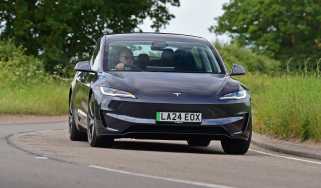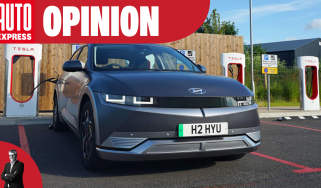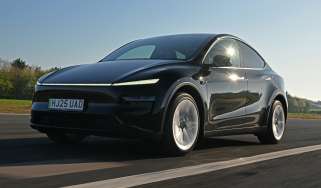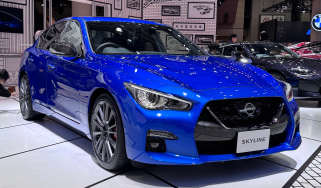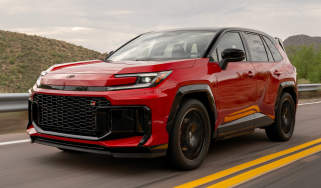Tesla, Trump and tumbling sales: what’s the problem with Elon Musk’s EV brand?
Revenue from Tesla’s car sales dropped by a fifth in Q1 compared to 2024, with Elon Musk stating he will step back from his US government role under President Trump to fulfil his CEO duties

Tesla has denied that it’s been headhunting for a new CEO following a recent earnings call that showed a dip in sales and earnings, with experts blaming this on Elon Musk’s own “toxicity”.
Reports surfaced recently that the company is scrambling to replace Musk due to the typhoon of controversy that surrounds him, but Tesla chair Robyn Denholm said in a statement on X that such rumours are “absolutely false”. She also reaffirmed that “the CEO of Tesla is Elon Musk, and the Board is highly confident in his ability to continue executing on the exciting growth plan ahead”.
Musk himself has also refuted these claims, which originally circulated via an article from the Wall Street Journal. The world’s richest man took to X to vent his anger, writing: “It is an extremely bad breach of ethics that the WSJ would publish a deliberately false article and fail to include an unequivocal denial beforehand by the Tesla board of directors”.
This comes soon after Tesla’s Q1 2025 earnings call which detailed that automotive earnings were down by as much as 20 per cent compared to last year, with overall profits down nine per cent. This makes the company’s situation far more dire than many analysts were expecting and comes alongside a 13 per cent drop in sales so far this year, which itself follows on from an overall dip in 2024; the number of new Tesla models registered fell to 1.79 million last year from 1.81 million in 2023.

Many experts have attributed this dip in sales to Musk himself, with Professor of Business Economics at the University of Birmingham, David Bailey, telling Auto Express that: “Tesla is getting a hammering, largely due to the toxicity of Elon Musk, but also the fact that the competition has heated up, especially from China and the likes of BYD.”
Bailey believes that a recovery for Tesla “requires Musk’s departure” altogether, despite the CEO’s enigmatic personality being one of the main factors that drew buyers to the brand in the first place. He continued: “A recovery is possible by focusing on getting [another] mass market car to market and, like the CEO of Ryanair once said, by ‘trying not to p**s our customers off so much’.”
Musk’s political controversy
A lot of Musk’s controversy surrounds his involvement with the newly formed US Department of Government Efficiency (DOGE); the billionaire himself even admitted this during the earnings call, stating that: “As some people know, there’s been some blowback for the time that I’ve been spending in government with the Department of Government Efficiency. I think the work that we’re doing there is actually very important for trying to rein in the insane deficit that is leading our country to destruction.”
Recently, Musk appeared on the White House lawn with none other than President Donald Trump after the latter posted on social media that he was going to “buy a Tesla as a show of confidence in Elon Musk” – something that undoubtedly alienated many Democrat voters, or anyone with opposing views to Trump.
Of course, not all of Musk and Trump’s views align; the President’s recent changes to the US’ tariffs on automotive imports is probably to appease the likes of Musk, who would have been hit hard by the hefty duties placed on the imports of foreign-made parts.
Before these changes were announced, Musk told investors: “I’ve been on the record many times saying that I believe lower tariffs are generally a good idea for prosperity, but this decision is fundamentally up to the President of the United States. So, you know, I’ll continue to advocate for lower tariffs rather than higher tariffs, but that’s all I can do.”
In fact, Musk appears to be so aware of how his political actions may be impacting the success of the electric car firm, he confirmed in the call that “starting next month, May, my time allocation to DOGE will drop significantly. I’ll have to continue doing it for the remainder of the President’s term… but starting next month, I’ll be allocating more of my time to Tesla”.
Is it all Musk’s fault?
Nevertheless, it’s unfair to pin the entirety of Tesla’s dip in profits on Musk; Tesla blamed the dip in global profits on slow deliveries, and stated that it would continue to streamline the production process – particularly for more bespoke models (ie those ordered without the base colour, wheels etc.).
There’s also the issue of increased competition from European manufacturers that have managed to catch up with Tesla’s technology over the past few years, as well as a raft of new brands hailing from China and bringing with them models that vastly undercut rivals in terms of price.
In fact, Tesla still seems to be going from strength to strength in the UK; in the first quarter of 2025, Tesla registered 12,500 new vehicles, which is an increase over the 11,786 registered for the same period in 2024. Of course, we expect this to dip slightly over the next couple of months as the old Model Y goes out of production and the facelifted examples begin trickling in at the beginning of May, before arriving en masse in June.
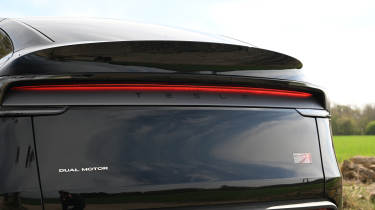
We asked Tesla UK to confirm these timelines and while the brand refused to comment officially, it did indicate that our assessment was accurate.
Despite this, Musk has appealed to investors, claiming that the firm isn’t “on the ragged edge of death, not even close. But there are some challenges, and I expect that this year… there will probably be some unexpected bumps. But I remain extremely optimistic about the future of the company.”
New Tesla products
With UK deliveries of the facelifted Tesla Model Y expected to arrive this month, Tesla is now putting huge emphasis on the launch of its autonomous ride-hailing service in Austin, Texas, in June of this year. This will use Model Y cars initially, before the Cybercab robotaxi enters production in 2026.
Whether this will be able to stimulate interest and optimism in the Tesla brand is another question altogether. However, Musk himself predicts that there will be “millions of Teslas operating [fully] autonomously in the second half of next year”.
Our dealer network has 1,000s of great value new cars in stock and available now right across the UK. Find your new car…
Find a car with the experts



